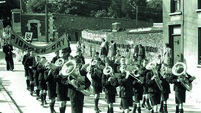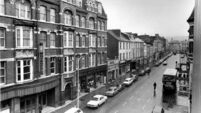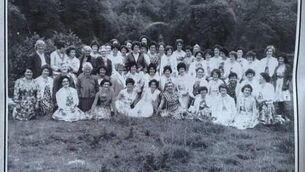Throwback Thursday: 20 piglets in a race in Kinsale for the ages!

Brian Cronin with a piglet ahead of the race in Kinsale in the early 1970s, along with Pat Roche, Anne Allen of Murphy’s hotel, Mrs Peggy Green, and Chris Stokes
We have had a wonderful story sent to us by Throwback Thursday reader Brian Cronin, hotelier par excellence, now retired, which you could with justification call - to borrow from the Beatrix Potter book title - ‘The Tale of Pigling Bland’.
“This photograph was taken way back in 1973/4, and I thought your readers would enjoy the story that goes with it,” starts Brian, in relation to the picture on the facing page.
“The photograph shows me (in company with farmer Dinny Delaney’s piglet) and, from left to right, the Cork/Kerry Tourism manager Pat Roche, Anne Allen of Murphy’s hotel, Mrs Peggy Green, our marvellous ‘Lady of the Sharks’, and Chris Stokes (who in later years designed and built a Tidal Clock for our Blue Haven Hotel.)
“Anne had a bit of a job laundering my dress suit after the winning piglet did a job on it later!”
In those early years of the 1970s, explains Mr Cronin, “we were trying to come up with various ways of raising funds for our Kinsale Tourist Promotions group, as Bord Fáilte grants had dried up thanks to the Troubles.
“We had to look to our own devices and start promoting Kinsale to the home market as our UK and USA business had also collapsed for the same reasons.”
So, where does the pig come in?!
“On the night in question, we had a Pig Race on the front lawn of Acton’s Hotel,” reveals Brian.
“We spent the weeks prior to the event persuading every business in town to sponsor a pig, including the two visiting French naval vessels, La Belle Poule and l’Etoile.
“Dunderrow farmer Dinny Delaney provided us with 20 piglets for the event and we got a few Carrigaline pipers to take up their position on the starting line to encourage the piglets into motion.
“Each of the ‘sponsors’ was provided with a long stick with a bunch of feathers attached to tickle their pig’s rear end. A local character called ‘Honest Dave’ set up a bookie’s stand on the lawn and took bets.”
They were under starter’s orders... and they were off.
“In the excitement of the race, the enthusiastic French sailors dragged their piglets along by the ears, and the squealing of pigs was only surpassed by the wailing of several of the female onlookers who got a bit upset at the sight,” recalls Brian.
“It was all great fun though, and we made quite a bit of money from the event.
“I reversed the floodlights from beaming up the front of the hotel to point them on the ‘race track’. Fortunately, we kept the event under wraps from my bosses in Dublin until the lawn had been restored to its former glory by our gardener…”
Brian continues: “The event was followed by a Bacon and Cabbage Supper (what else?) which went down very well for everybody, with the exception of our guest journalist George Cronin who was a vegetarian.
“But my chef made up a special dish for him and he subsequently wrote a nice article in the Examiner, so all ended well.”
What enormous fun, Brian! We really have to hand it to you for thinking up profitable ideas when our tourism industry was in a bad place. More memories of those days, please!
Now, here is something very touching from Anthony Bevan, who vividly recalls even tighter times, when households didn’t even have the proverbial two pennies to rub together, and relied on manna from heaven – or, to be precise, contributions from overseas.
“Growing up on Spangle Hill in the 1950s, most houses had some member of the family abroad earning their wages - most of these emigrants were in England,” says Anthony.
“I well remember our postman (Jeff – I never knew his surname, he was just Jeff to everyone) would arrive on a Monday morning in rain, snow or sunshine, without fail.
“He visited every house for which he had post, but the important ones were those which were getting registered letters. Those, as we all knew, had money in them.”
Anthony continues: “The procedure with these all-important missives was that Jeff would slowly and laboriously extract a pencil from his pocket and touch it on his tongue to activate it, before getting the householder to write their name on his piece of paper, just to prove they got the letter.
“You wouldn’t believe how he was welcomed on Monday mornings unless you’d been living in that part of Cork at that time. More than any other morning, as this was literally the ‘red letter day’ for so many houses. Ours as well, as we had family working over in the UK too.
“In fact, I would have classified Jeff as the most important man in the world to us, as that money went a long way to make things a bit better.
“There were a lot of unemployed people and a great deal of worry back then on Spangle Hill.”
Isn’t that a great recollection of one of the stark facts of 1950s life in our city? Grand ladies might meet each other for morning coffee at the Green Door, or afternoon tea and gossip at the Savoy, but up on Spangle Hill the arrival of that letter, carefully sealed, stamped, and posted in an industrial English city, meant the difference between food on the table and – well, hunger.
You have to give all credit to the hard workers in Dagenham or elsewhere, getting to the end of an exhausting week and surely feeling so tempted to go down for “just one” at the inviting local pub. But instead, they stuffed most of their wages into those envelopes and sent them home to the family they missed so much.
Thank-you so much for sharing that memory with us, Anthony.
And that reminder of harder times and what our parents and grandparents had to do to survive got us thinking. Isn’t it time in this crazy throwaway world that we took up the old old ways of doing things, and used old kit and equipment that would still work excellently if we hadn’t consigned it to the attic or the garage?
Yes, it is time, and you know it.
Just because you can pick up something new that was probably made at the other side of the world and imported at considerable cost, is that any reason to dump yesterday’s traditions? What’s wrong with your dad’s old saw that cut so many logs to size, and shaped the wood for those shelves? Where did your mum’s old sewing machine go? The one on which she made all those Communion dresses, those gym slips, your first evening gown?
Remember the sound of the treadling going on all evening, or the comforting rhythm of the wheel being turned?
Do you really need that supersonic, modern, electric whizz-kid clever-clogs device which does all your thinking for you, and then goes off thinking for itself, which you didn’t want at all?
We recently met a woman who confessed that she had gone back to using her grandmother’s vintage hand-cranked sewing machine because she simply couldn’t stand the demands her expensive new model made on her mind and her stress levels.
“I just wanted to sew some seams, that was all. I didn’t want to have to take a degree in computer skills,” she expostulated.
Well, that got me searching, and what do you know, she wasn’t alone. The Americans, of course, were ahead of us in this, and the number who have gone back to the simpler days of making do and mending is growing exponentially.
Hopefully it’s happening here too, although it took us time to get out of the habit of being ashamed of the old ways.
There is a marvellous example of the old ways being honoured down at Muckross House in Killarney, where they create the most beautiful scarves, stoles, wraps, capes, in magical colours, which sell like hot cakes to both tourists and local residents who know quality when they see it. They have even featured in Riverdance!
And the overseas market is booming too, great boxes going out to every corner of the world, showing just what beautiful things we make in Ireland.
John Cahill is Master Weaver here, overseeing the entire business. He works, not in a huge modern factory, but in an elderly shed where vintage looms clack away as well as they did in the 19th century.
“I went into Muckross straight from school in 1976,” explains John. “It was one of the few places you could find a job at that time in Killarney. The house was getting very popular with visitors and one of the ideas they’d introduced was to give demonstrations as part of the tour, showing how the old crafts were done when great houses had all their own staff to supply their needs.

“It was a great idea because people don’t always realise how self-sufficient a big country estate was in earlier times, and it was a great success.
“And then they had the idea of actually selling the things that were made. And it just developed and grew from there.”
Today, John still treasures the old-fashioned ways of working that were almost dying out when he came to Muckross.
“I never had a particular bent for arts or crafts at school,” he says. “I wouldn’t know what to do with a paintbrush and I wouldn’t have thought of myself as all that handy.”
Nevertheless, he took to weaving like a duck to water and has seen it grow into an international business.
“I’d take a hand at anything - fixing a loom, sorting out the packing, folding up a scarf , taking a package to the post office or talking to customers.
“In a place as small as this, you have to be involved in everything. We’re like one big extended family really, just like it would have been in the old days.”
And that’s where our point is made. Fixing a loom.
The looms that John tends as lovingly as any shepherd does his newborn lambs, were originally hand- and foot-powered, and came from old mills across Ireland, and some even from the Outer Hebrides, where they were once used to make Harris and Donegal tweed.
“We’ve collected them over the years from all kinds of places and converted them to electric power,” explains John. “They’re great little things but it’s a problem getting parts these days.
“If I ever hear on the grapevine of one for sale somewhere, I’ll be off to get it, if only for the spares.”

So says John, adjusting a very practical length of knotted string which seems to play a vital part in the operating of a 19th century Hattersley.
Now come on, isn’t it heartening to see these great old wooden machines still doing the job they were built for?
Doesn’t it warm your heart to witness the traditional ways being honoured?
They were taken for granted back when we lived in harder times, and make do and mend was part of everyday life.
Do you have a memory of a grandfather patiently mending the broken leg of a chair? A grandmother who darned those holes in your socks? A friendly uncle who showed you how to repair the damage to your tricycle?
For goodness’ sake, let’s get back, at least a little, to the old ways and the old methods.
In these strange modern times, there is something supremely relaxing about working with your hands to make something as good as new.
Tell us your memories! Email jokerrigan1@gmail.com. Or leave a message on our Facebook page: www.facebook.com/echolivecork.







